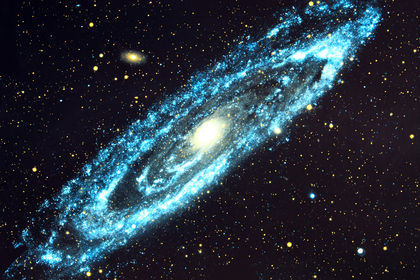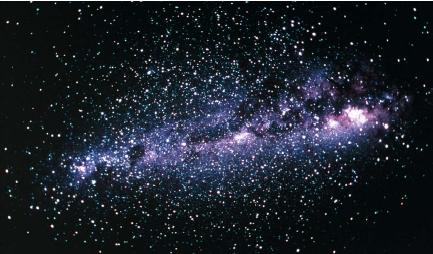Galaxy

A galaxy is a large collection of stars, glowing nebulae (clouds), gas, and dust bound together by gravity. Many scientists now believe that a black hole, the remains of a massive star, lies at the center of many galaxies. Galaxies are as plentiful in the universe as grains of sand on a beach. The galaxy that contains our solar system is called the Milky Way. The Milky Way is part of a cluster of some 30 galaxies known as the Local Group, and the Local Group is part of a local supercluster that includes many clusters.

Although astronomers are not yet sure how galaxies formed and evolved, the process must have occurred quickly very early in the history of the universe. The age of the oldest galaxies appears to be about the same age as the universe, which is estimated to be 10 to 13 billion years old.
Words to Know
Barred spiral galaxy: A spiral galaxy in which the spiral arms start at the end of a central bar structure rather than the nucleus.
Black hole: The remains of a massive star that has burned out its nuclear fuel and collapsed under tremendous gravitational force into a single point of infinite mass and gravity.
Dark matter: Unseen matter that has a gravitational effect on the motions of galaxies within clusters of galaxies.
Halo: A distribution of older stars and clusters of stars surrounding the nucleus of a spiral galaxy.
Irregular galaxy: A galaxy that does not fit into the shape categories of elliptical and spiral galaxies.
Light-year: The distance light travels in one year, roughly 5.88 trillion miles (9.46 trillion kilometers).
Milky Way: The galaxy in which we are located.
Nebulae: Bright or dark clouds, often composed of gases, hovering in the space between the stars.
Nucleus: The central core of a galaxy.
Radio waves: Electromagnetic radiation, or energy emitted in the form of waves or particles.
Spiral arms: The regions where stars are concentrated that spiral out from the center of a spiral galaxy.
Spiral galaxy: A galaxy in which spiral arms wind outward from the nucleus.
The shape of galaxies
Galaxies can be spiral, elliptical, or irregular in shape. The Milky Way and nearby Andromeda galaxy are both spiral shaped. They have a group of objects at the center (stars and possibly a black hole) surrounded by a halo of stars and an invisible cloud of dark matter. From this nucleus or center, arms spiral out like a pinwheel. The spiral shape is formed because the entire galaxy is rotating, with the stars at the outer edges forming the arms. Most spiral galaxies have just one arm wrapped around the nucleus, although some have two or even three arms.
Spiral galaxies are divided into two types: barred and unbarred. In barred spirals, a thick bar of stars crosses the center of the galaxy. Unbarred spirals have no such feature.
An elliptical galaxy contains mostly older stars, with very little dust or gas. It can be round or oval, flattened or spherical, and resembles the nucleus of a spiral galaxy without the arms. Astronomers do not yet know whether elliptical galaxies eventually form arms and become spirals, or if spiral galaxies lose their arms to become elliptical.
About one-quarter of all galaxies are irregular in shape and are much smaller than spiral galaxies. The irregular shape may be caused by the formation of new stars in these galaxies or by the pull of a neighboring galaxy's gravitational field. Two examples of an irregular galaxy are the Large and Small Magellanic Clouds, visible in the night sky from the Southern Hemisphere.

Some galaxies are variations of these types. There are the Seyfert galaxies (violent, fast-moving spirals); bright elliptical galaxies of super-giants that often consume other galaxies; ring galaxies that seem to have no nucleus; twisted starry ribbons formed when two galaxies collide; and others.
The Milky Way
The Milky Way is a barred spiral galaxy about 100,000 light-years across. Its disklike nucleus, which bulges to about 30,000 light-years thick, contains billions of old stars and maybe even a black hole. It has four spiral arms. Our solar system is located in the Orion arm, about 30,000 light-years from the center of the galaxy.
Just as Earth revolves around the Sun, the Sun revolves around the nucleus of the galaxy. Traveling at a speed of about 155 miles (250 kilometers) per second, the Sun completes one revolution around the galactic center in about 220 million years.
Active Galaxies
An active galaxy is one that emits far more energy than a normal galaxy. The Milky Way, like most galaxies, is relatively stable and quiet. Active galaxies, on the other hand, give off more than 100 times the energy of the Milky Way. Explosions at the nucleus of active galaxies spew huge jets of material hundreds of thousands of light-years into space. The energy is emitted as radio waves (electromagnetic radiation) rather than optical light. There are several varieties of active galaxies, including Seyfert galaxies and quasars.
Seyfert galaxies look like spiral galaxies with a hyperactive nucleus. The normal-looking spiral arms surround an abnormally bright nucleus. Quasars are the most interesting of active galaxies. A quasar can emit more energy in one second than our sun has in its entire lifetime. Quasars, which look like stars, are the most distant and energetic objects in the universe known so far. Most astronomers consider a quasar to be the very active nucleus of a distant galaxy in the early stages of evolution. The light from a quasar has been traveling toward Earth for billions of years, perhaps from the very beginning of the universe.
In ancient times, people looked into space and saw a glowing band of light. They thought it resembled a river of milk and called it the Milky Way. In the late 1500s, Italian physicist and astronomer Galileo Galilei (1564–1642) first examined the Milky Way through a telescope and saw that the glowing band was made up of countless stars. As early as 1755, German philosopher Immanuel Kant (1724–1804) suggested that the Milky Way was a lens-shaped group of stars, and that many other such groups existed in the universe.
Over the years, astronomers learned more about the shape of the Milky Way, but they continued to place our solar system at the center. In 1918, American astronomer Harlow Shapley (1885–1972) studied the distribution of star clusters and determined that our solar system was not at the center, but on the fringes of the galaxy.
Hubble and the expanding universe
In 1924, American astronomer Edwin Hubble (1889–1953) first proved the existence of other galaxies. Using a very powerful 100-inch (254-centimeter) telescope at Mount Wilson Observatory in California, he discovered that a group of stars long thought to be part of the Milky Way was actually a separate galaxy, now known as the Andromeda galaxy. Modern estimates place Andromeda 2.2 million light-years away from the Milky Way. Hubble also discovered many other spiral-shaped galaxies. In 1927, Dutch astronomer Jan Oort (1900–1992) showed that galaxies rotate about their center.
Beyond these important discoveries, Hubble found that more distant galaxies are moving away from us at a faster rate. From this observation, known as Hubble's Law, he deduced that the universe is expanding, a fundamental fact about the nature of the universe.
In early 1996, the Hubble Space Telescope sent back photographs of 1,500 very distant galaxies in the process of forming, indicating that the number of galaxies in the universe is far greater than previously thought. Based on this and other discoveries in the late 1990s, astronomers have estimated the number of galaxies to be 50 billion.
[ See also Quasar ; Radio astronomy ; Solar system ; Star ; Starburst galaxy ]
Is the milky way an active galaxy?
Thanks very much for your help
Tom
found in the Universe that no
one know only the scientists?
Thanks...
Hanema